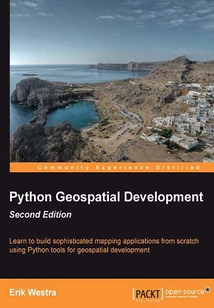首頁 > 計算機(jī)網(wǎng)絡(luò) >
編程語言與程序設(shè)計
> Python Geospatial Development(Second Edition)最新章節(jié)目錄
舉報 

會員
Python Geospatial Development(Second Edition)
最新章節(jié):
Index
ThisisatutorialstylebookthatwillteachusageofPythontoolsforGISusingsimplepracticalexamplesandthenshowyouhowtobuildacompletemappingapplicationfromscratch.ThebookassumesbasicknowledgeofPython.NoknowledgeofOpenSourceGISisrequired.ExperiencedPythondeveloperswhowanttolearnaboutgeospatialconcepts,workwithgeospatialdata,solvespatialproblems,andbuildmap-basedapplications.ThisbookwillbeusefulthosewhowanttogetuptospeedwithOpenSourceGISinordertobuildGISapplicationsorintegrateGeo-Spatialfeaturesintotheirexistingapplications.
目錄(89章)
倒序
- 封面
- 版權(quán)信息
- Credits
- About the Author
- About the Reviewers
- www.PacktPub.com
- Preface
- Chapter 1. Geospatial Development Using Python
- Python
- Geospatial development
- Applications of geospatial development
- Recent developments
- Summary
- Chapter 2. GIS
- Core GIS concepts
- GIS data formats
- Working with GIS data manually
- Summary
- Chapter 3. Python Libraries for Geospatial Development
- Reading and writing geospatial data
- Dealing with projections
- Analyzing and manipulating geospatial data
- Visualizing geospatial data
- Summary
- Chapter 4. Sources of Geospatial Data
- Sources of geospatial data in vector format
- Sources of geospatial data in raster format
- Sources of other types of geospatial data
- Choosing your geospatial data source
- Summary
- Chapter 5. Working with Geospatial Data in Python
- Pre-requisites
- Reading and writing geospatial data
- Changing datums and projections
- Representing and storing geospatial data
- Performing geospatial calculations
- Converting and standardizing units of geometry and distance
- Exercises
- Summary
- Chapter 6. GIS in the Database
- Spatially-enabled databases
- Spatial indexes
- Open source spatially-enabled databases
- Commercial Spatially-enabled databases
- Recommended best practices
- Working with geospatial databases using python
- Summary
- Chapter 7. Working with Spatial Data
- About DISTAL
- Designing and building the database
- Downloading the data
- Importing the data
- Implementing the DISTAL application
- Application review and improvements
- Summary
- Chapter 8. Using Python and Mapnik to Generate Maps
- Introducing Mapnik
- Creating an example map
- Mapnik in depth
- MapGenerator revisited
- Map definition files
- Summary
- Chapter 9. Putting It All Together – a Complete Mapping System
- About ShapeEditor
- Designing ShapeEditor
- Prerequisites
- The structure of a Django application
- Setting up the database
- Setting up the ShapeEditor project
- Defining the ShapeEditor's applications
- Creating the shared application
- Defining the data models
- Playing with the admin system
- Summary
- Chapter 10. ShapeEditor – Implementing List View Import and Export
- Implementing the "list shapefiles" view
- Importing shapefiles
- Exporting shapefiles
- Summary
- Chapter 11. ShapeEditor – Selecting and Editing Features
- Selecting a feature to edit
- Editing features
- Adding features
- Deleting features
- Deleting shapefiles
- Using ShapeEditor
- Further improvements and enhancements
- Summary
- Index 更新時間:2021-08-20 16:55:38
推薦閱讀
- 從零開始構(gòu)建企業(yè)級RAG系統(tǒng)
- C# Programming Cookbook
- Vue.js 3.0源碼解析(微課視頻版)
- Python自然語言處理(微課版)
- Mastering Python High Performance
- Mastering Yii
- Monitoring Elasticsearch
- EPLAN實(shí)戰(zhàn)設(shè)計
- Working with Odoo
- Learning Unity 2D Game Development by Example
- Python極簡講義:一本書入門數(shù)據(jù)分析與機(jī)器學(xué)習(xí)
- PHP編程基礎(chǔ)與實(shí)踐教程
- Python 3.7從入門到精通(視頻教學(xué)版)
- Delphi開發(fā)典型模塊大全(修訂版)
- ASP.NET Web API Security Essentials
- NGUI for Unity
- Practical Predictive Analytics
- 視窗軟件設(shè)計和開發(fā)自動化:可視化D++語言
- Spring Microservices
- Comprehensive Ruby Programming
- Visual C++ 2017網(wǎng)絡(luò)編程實(shí)戰(zhàn)
- Microsoft Hyper-V PowerShell Automation
- Tableau數(shù)據(jù)可視化從入門到精通
- PHP7實(shí)踐指南:O2O網(wǎng)站與App后臺開發(fā)
- Learning AirWatch
- Building Data Streaming Applications with Apache Kafka
- WebRTC音視頻實(shí)時互動技術(shù):原理、實(shí)戰(zhàn)與源碼分析
- JavaScript Domain:Driven Design
- Boost.Asio C++ Network Programming
- PHP程序開發(fā)范例寶典

